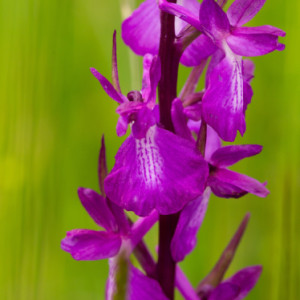Silver-studded Blue
Following breakfast it was time to bid farewell to our host Adriana in Măgura and head northwards away from the Carpathians and on to a landscape of rolling hills, valleys, meadows and woodlands. Our first stop was the wetlands of the Dumbravita Fishing Complex, a Special Protection Area and Ramsar site, which has found a compromise between an active fishery and bird conservation.
Passing between two of the lagoons there was a cacophony of warbler song. The loud and clunky clamour of Great Reed Warbler almost drowned out the stuttering mimicry of Marsh Warbler and the jumble of Sedge Warbler, and several of these oversized warblers could be seen blasting out their songs. More reserved were the Savi's Warblers, quietly reeling low in the vegetation. We found a Penduline Tit nest close to the path, and with some patience had fleeting views as the adult birds bustled around.
The weather was still mixed, although a marked improvement on our first few days, which helped us improve our tally of invertebrates. A White-tailed Skimmer was the largest of several species of Odonata, and a lovely fresh Red-tipped Clearwing was spotted resting in vegetation. We also spotted the tell-tale feeding signs of Beavers, and some of the group saw a Striped Field Mouse before it disappeared into the vegetation.
The site is important for herons and we spotted plenty of Night Herons, along with Great Egret, Little Egret, Squacco Heron and Grey Heron. Whiskered Terns called noisily as they patrolled the waters, and
were joined by Black Terns and a solitary Sandwich Tern (an uncommon species here). Marsh Harriers patrolled the vegetation, and we spotted several Pygmy Cormorants; this is the only breeding colony of this species in Transylvania.
There were plenty of interesting plants to be found including Swallow-wort Vincetoxicum hirundinaria and Brown Knapweed Centaurea jacea , as well as a good selection of legumes, including the large pink Ruddy Clover Trifolium rubens , Hungarian Clover Trifolium pannonicum and Hare's-foot Clover Trifolium arvense .
Along with an occasional shower, the sun also put in an appearance, encouraging butterflies into the air and an increasingly loud chorus from the Marsh Frogs. We found a selection of butterflies here including Silver-studded Blue, Large Copper, Woodland Ringlet and Knapweed Fritillary, alongside the Black-veined White Moth.
Driving a little further we stopped to explore a meadow near the village of Fişer. Typical flowers such as Field Scabious Knautia arvensis , Ragged-Robin Silene flos-cuculi and Selfheal Prunella vulgaris were found here alongside the 'easy to miss' Grass Vetchling Lathyrus nissolia and the gloriously velvety Downy Woundwort Stachys germanica . The meadow was alive with crickets and grasshoppers, including the impressively large Wart-biter. A large patch of Bug Orchid Anacamptis coriophora was soon overshadowed by a colony of the striking tall and dark Lax-flowered Orchid Anacamptis laxiflora .
Finally we continued on for the final stretch of our journey to the village of Crit, where we were greeted by our hosts Tibi and Mihaela who showed us to our rooms in the carefully restored Saxon houses of Casa cu Zorele before a welcome introduction to Mihaela's superb cooking.
Extract from Wildlife Travel Transylvania trip report, Laurie Jackson, June 2019



Comments
Sign in or get an account to comment.


